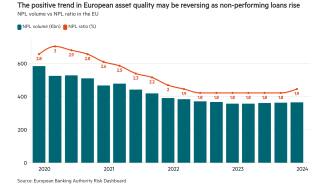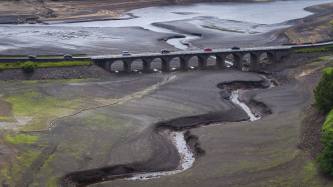Federico Sforza is a start-up co-founder with more than two decades of experience at Nexi, Unicredit and ING Italy, where he was head of the SMEs business unit. Mr Sforza could have continued his trajectory to the top of Italian corporate banking, but instead he launched a new bank with his own money in the middle of the Covid-19 pandemic.
Milan-based fintech bank Banca AideXa has provided more than €500m in business loans to Italian small and medium-sized enterprises (SMEs) over three years.
Today, Banca AideXa has more than 10,000 customers — including 3000 micro-enterprises and SMEs — with an average loan size of less than €200,000. It recently added a business current account and a no-notice deposit account to its range of digital-first products. Mr Sforza remains at the helm, along with co-founder and chair Roberto Nicastro.
Q: SMEs account for nearly 80% of the Italian industrial and service labour force. What is the biggest challenge they face?
A: Fast access to liquidity when they need it most. There’s a clear gap between supply and demand. It had been very clear to me, in other projects, in talking with the thousands of SMEs and micro companies, there was a huge need for something different and something responsive. Entrepreneurs need very fast answers. But a typical process, fully based on profit and loss (P&L) balance sheet analysis, is very lengthy — it can take 60 to 90 days before you get an answer and it often does not take into account the real cash flow of the company. Entrepreneurs just don’t have that sort of time.
Q: What’s a typical Banca AideXa SME customer?
A: A small or micro business that needs immediate working capital, but might not be the right candidate for a traditional bank because the loan size is too small or the historic P&L would not pass risk assessments.
A good example is Palzola, a cheese-making company founded in 1948 that has been dedicated to the production of gorgonzola. Our financing helped the company bridge the mismatch between the payment of raw materials and the settling of invoices — which is particularly accentuated for a product like gorgonzola, which requires long maturing times, and [the company’s] costs were skyrocketing due to the energy crisis.
A loan of €300,000 helped the company manage its cash flow and then enabled it to expand into new markets and innovate with new technologies and materials.
Q: Banca AideXa is 100% digital first. What was the thinking behind this approach?
A: I’d been thinking about it a lot. I’d been working days and nights and meeting with [co-founder] Roberto Nicastro, and I was fully convinced there was a great opportunity to launch a fully digital proposition, based on data — because there was a huge disruption coming out in the market in the form of the second Payment Services Directive, known as PSD II. This enables third parties to access checking account data of the SME in one click: instant access to tonnes of information on the business, its cash flows, its pricing, its client base — all in real time.
Roberto was keen to offer different transactional services, so we put together the two ideas. Now starting a bank from scratch is no walk in the park, but we knew there was an opportunity there.
Q: You mention PSD II, which came into force in Italy in 2018. How has it influenced your products and services?
A: Our products are native to PSD II. This means since the very beginning we have been able to harness data for a number of purposes. The key being credit risk assessment.
PSD II means it’s now compulsory for banks to share information, so we get real-time data and in-depth transaction histories. When the economic cycle is compressed to a number of months, the P&L balance sheet statements of two or more years become useless. But if you observe the real-time cash flow that the company has been building in the last 24, 12 or even three months, then it gives you an edge in understanding the company and whether the client is creditworthy.
This was especially useful during the pandemic. But it’s also true in the other economic phases we’ve since faced — such as the energy crisis, and the war in Ukraine.
Q: You launched in 2020 — during the pandemic lockdowns — how did you approach that unique challenge?
A: We were ready to launch and the pandemic hit. First, of course, we were puzzled — what to do? We were shocked like everybody; it was clear it was a tragedy. But we discussed it among ourselves and our families and thought that it was actually the right time. Sooner or later the economy would have even more needs in working capital to restart and grow, and we saw a big push to digitalisation.
So in between the tragedy, like in every bad time, there were opportunities and one of those was the move to digitalisation that we’re still experiencing now. There’s clearly been a real cultural shift — even in the elderly population, who are now at ease with video calls and so on. We knew we’d have one or two tough years, but then we knew we could be ready.
Even Bank of America was born from a crisis [following the San Francisco earthquake of 1906], so we said that there isn’t a better time to start lending to SMEs.
Q: What sort of specific opportunities arose from the pandemic?
A: Traditional banks were blacklisting entire sectors, for example restaurants, because they were closed. So we decided instead to launch an initiative dedicated to restaurants. We were able to understand, from data, that the viable restaurants who converted themselves to home delivery simply needed working capital. We’ve been able to serve entire industries, who wouldn’t otherwise have been served.
The same holds true during the energy crisis. And we were able to do it because of the data. It is now compulsory for banks to give us all the banking data connecting clients’ accounts, and we are able to build sophisticated artificial intelligence models that can check whether the client is giving us all their information or if some is missing.
Then, in terms of what we could do, we built AI models from the very beginning, not only on our data, but in partnership with other Italian banks. So we were able to get 10 years of data, hundreds of thousands of SMEs’ data, checking account data — so we were able to construct a very, very solid model based on 10 years of history. That gave us an edge and we are continuing to evolve our credit assessment model.
Q: How have customers responded to the ‘digital first’ approach?
A: They are extremely enthusiastic for a couple of reasons. The key point is that they are actually able to get the money, and get a real-time answer extremely fast — between four and 20 days — 20 days if there are state warranties behind it. But still this is a tremendous step compared with 90 days. And they can do it simply: they just need to put in the VAT code and connect their accounts. All the rest of the complexity of a loan application is handled by us.
The other key reason is that we are starting to provide a dynamic line of credit. The more we understand about the customer and the more we understand their cash flow, there is the possibility to get additional financing — or for example, the option to swap a fixed rate with a variable rate.
Q: What’s next in terms of using the data?
A: Looking forward, there are really a number of different applications that are banking-wide and can cover really different needs. Next we’re going to look at pricing. We’ll be able to use our models also to understand what our clients are currently paying in other banking transactions, and we’ll be able to offer a more competitive price.
We are also using it for anti-money laundering [AML], for instance, because clearly you can understand certain patterns in transactions and better understand fraud.
Q: Banca AideXa has now surpassed €500m in business loans to Italian SMEs, and it’s now offering a business current account and deposit account. Where do you see the real growth?
A: We are still a young start-up. We got our official banking licence in 2021. And that’s when we started to really grow. So in just a couple of years, we’ve been able to finance €500m with a very high quality of risk. Now we are starting to enter into the checking account world and into the transactional side. Because of that, we are actually expecting to boost growth in terms of the number of customers, because we are now talking to a wider population.
For next year, we will continue to expand the area of artificial intelligence to other areas of the bank, not only credit or AML, but also in terms of services. We are continuing to invest in making the customer experience as simple as possible. We recently released a different self-identification system, linked to the state system [SPID — Italy’s public digital identity system, which offers access to online public services], so all you need is a username and password and you are identified without any further complexity.
The main point is that we’ll keep evolving our models. Of course, one of the things we pay a lot of attention to is the data lake — it is the backbone of our company and we use it for every decision. It is also a treasure, but there are more treasures inside it, still waiting to be discovered.












